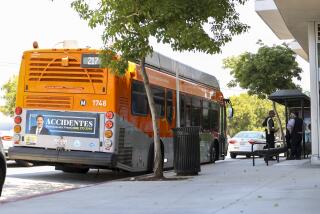Regional Plan Adopted for Trail Network
- Share via
Transportation officials adopted a regional plan Friday that links most of the populated areas of Ventura County with almost 150 miles of bike and equestrian paths.
But more than half of the trails identified in the Ventura County Regional Bikeways Plan have never been built, and there is no money to buy the land on which the trails would lie or to pay for their construction.
“There’s not any money to build this plan,” said John K. Flynn, chairman of the Ventura County Transportation Commission. “So things [in the plan] are going to change.”
Commission planners last year were asked to develop a regional trails plan that would connect most of the communities in Ventura County with paths that would be used by non-motorized forms of transportation.
The information will go into a thick transit report called a Regional Comprehensive Plan, compiled every two years by the Southern California Assn. of Governments, which plans transportation projects.
Despite the lack of money for almost 90 miles of unbuilt paths, the trails blueprint has a purpose.
Local transportation planners use the information to plot projects as money becomes available.
Every year, the federal government sets aside grants for promoting non-motorized transit projects, such as the Ventura River Bike Trail.
Two bike-path projects funded in recent years are the Ojai Valley Trail and the Santa Paula Branch Line, for which planning is underway.
The Ventura County Regional Bikeways Plan identifies 12 bike paths stretching 149 miles across the county. About 56 miles of the network are completed, and another six miles are being planned.
But more than 87 miles of the trail system are listed as “needed” in the regional plan. Preliminary cost estimates for those trails are about $7 million, not including the price of land.
Not everyone at the commission meeting Friday supported the Ventura County Regional Bikeways Plan.
“It’s a rather ill-conceived waste of taxpayer money,” said William Becher of Westlake. “There are better ways to spend money to encourage bike riding.”
Becher, who said he bikes more than 20 miles a week, said the little money available for bike trails should not be spent on Class I paths, which can cost $600,000 per mile. Rather, Transportation Commission members should focus on improving Class II bike lanes, which generally run along streets and highways, Becher said.
Ginger Gherardi, executive director of the county Transportation Commission, said the regional plan represents a best-case scenario, in which the Class I improvements would be constructed when there are no other demands on the limited money.
The plan “doesn’t deal with just recreational issues,” she said. “We needed to do it. We’re not obligated to build it ahead of highway projects.”
More to Read
Sign up for Essential California
The most important California stories and recommendations in your inbox every morning.
You may occasionally receive promotional content from the Los Angeles Times.













